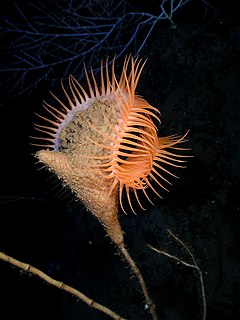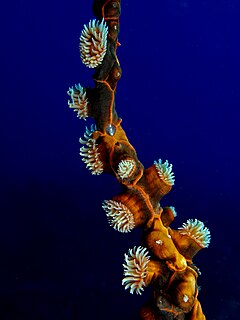
Actinoscyphiidae is a family of sea anemones.

Edwardsia is a genus of sea anemones, the type of the family Edwardsiidae. They have eight mesenteries and live in tubes in the sand. The name, in New Latin, commemorates the French zoologist Henri Milne-Edwards.

Corallimorpharia is an order of marine cnidarians closely related to stony or reef building corals (Scleractinia). They occur in both temperate and tropical climates, although they are mostly tropical. Temperate forms tend to be very robust, with wide and long columns, whereas tropical forms tend to have very short columns with a wide oral disc and very short tentacles. The tentacles are usually arranged in rows radiating from the mouth. Many species occur together in large groups, although there are recorded instances of individuals. In many respects, they resemble the stony corals, except for the absence of a stony skeleton. Morphological and molecular evidence suggests that they are very closely related to stony corals.

Amphianthus is a genus of sea anemones. It is the only genus in the monotypic family Amphianthidae.

Hormathiidae is a family of sea anemones in the class Anthozoa.
Halcampidae is a family of sea anemones. Members of this family usually live with their column buried in sand or other soft substrates.

Bunodactis is a genus of sea anemones in the family Actiniidae.

Epiactis is a genus of sea anemones in the family Actiniidae. There are about nineteen recognised species and the type species is Epiactis prolifera.

Actinia is a genus of sea anemones in the family Actiniidae. Actinia display a rare form of heteromorphosis in which a cut inflicted on a specimen can develop into a second mouth.

Liponema is a genus of sea anemones, in the family Liponematidae.

Edwardsiidae is a family of sea anemones. Edwardsiids have long thin bodies and live buried in sediments or in holes or crevices in rock.

Palythoa is a genus of anthozoans in the order Zoantharia.

Actinostola is a genus of sea anemones in the order Actiniaria. All members of this genus are deep-sea species, with some occurring at hydrothermal vents.

Actinostola callosa is a species of sea anemones in the family Actinostolidae in the order Actiniaria. It is a deep sea species and occurs in both Pacific and Atlantic Oceans from the continental shelf to abyssal depths.

Diadumene is a genus of sea anemones. It is the only genus in the monotypic family Diadumenidae.

Edwardsiella is a genus of sea anemones in the family Edwardsiidae. It is named in honour of Henri Milne-Edwards, an eminent French zoologist.

Paranthus is a genus of sea anemones in the family Actinostolidae.
Actinernidae is a family of sea anemones. It contains the following genera and species:
Andvakiidae is a family of sea anemones.
Anthosactis is a genus of cnidarians belonging to the family Actinostolidae.















